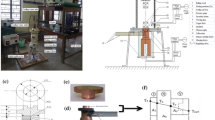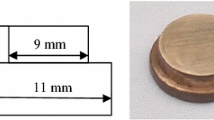Abstract
A novel surface modification approach, viz. electron beam evaporation method, was proposed for fabrication of nanoparticle-coated thin-film surface. The nucleate pool boiling heat transfer performance of untreated, treated, treated with titanium oxide and silicon oxide thin-film surfaces was experimentally investigated at atmospheric pressure. The surfaces were characterized with respect to contact angle, roughness, topography by contact angle analyzer and coating thickness, respectively. The contact angle was measured by sessile droplet method. The optical surface profiler is used for the measurement of surface roughness. Heat flux was varied from 50 to 145 W/cm2 in eight steps. In each run, heat transfer coefficient was calculated from the experimental data. After analyzing the data, it is found that thin-film surface is superior from the point of boiling heat transfer coefficient than other surfaces. The results showed a maximum of 45 and 60 % enhancement in heat transfer coefficient for higher thickness of silicon oxide and titanium oxide thin-film surface as compared to untreated surface. The highest enhancement of heat transfer coefficient in thin-film surfaces was due to level of wettability improvement, enhanced surface roughness and creating high-density active nucleate site on the surface. The experimental data were predicted with other published data, and some deviations in heat transfer coefficient were observed. The deviation of result compared with other published data is due to the operating conditions, surface types, coating thickness and method of coating.





Similar content being viewed by others
References
Ahn HS, Sinha N, Zhang M, Banerjee D, Fang SK, Baughman RH (2006) Pool boiling experiments on multi walled carbon nanotube (MWCNT) forests. J Heat Transf Trans ASME 128:1335–1342
Bejan A, Kraus AD (2003) Heat transfer handbook. John Wiley, Hoboken
Chen R, Lu MC, Srinivasan V, Wang Z, Cho HH, Majumdar A (2009a) Nanowires for enhanced boiling heat transfer. Nano Lett 9:548–553
Chen Y, Mo DC, Zhao HB, Ding N, Lu SS (2009b) Pool boiling on the superhydrophilic surface with TiO2 nanotube arrays. Sci China Ser E Technol Sci 52:1596–1600
Davis ME (2002) Ordered porous materials for emerging applications. Nature 417:813–821
Im Y, Joshi Y, Dietz C, Lee SS (2010) Enhanced boiling of a dielectric liquid on copper nanowire surfaces. Int J Micro-Nano Scale Transp 1:79–95
Jones BJ, McHale JP, Garimella SV (2009) The influence of surface roughness on nucleate pool boiling heat transfer. J Heat Transf 131(12):121009–121014
Kim S, Kim HD, Kim H, Ahn HS, Jo H, Kim J, Kim MH (2010) Effects of nano-fluid and surfaces with nano structure on the increase of CHF. Exp Therm Fluid Sci 34:487–495
Launay S, Fedorov AG, Joshi Y, Cao A, Ajayan PM (2006) Hybrid micro/nanostructured thermal interfaces for pool boiling heat transfer enhancement. Microelectron J. 37:1158–1164
Lee CY, Bhuiya MMH, Kim KJ (2010) Pool boiling heat transfer with nano-porous surface. Int J Heat Mass Transf 53:4274–4279
Li C, Peterson GP (2007) Parametric study of pool boiling on horizontal highly conductive microporous coated surfaces. J Heat Transf 129:1465–1475
Li C, Wang Z, Wang P, Peles Y, Koratkar N, Peterson P (2007) Nanostructured copper interfaces for enhanced boiling. Small 4:1084–1088
Liter SG, Kaviany M (2001) Pool-boiling CHF enhancement by modulated porous layer coating: theory and experiment. Int J Heat Mass Transf 44:4287–4311
Lu MC, Chen R, Srinivasan V, Carey VP, Majumder A (2011) Critical heat flux of pool boiling on Si nanowire array-coated surface. Int J Heat Mass Transf 54:5359–5367
Saeidi D, Alemrajabi AA (2013) Experimental investigation of pool boiling heat transfer and critical heat flux of nanostructured surfaces. Int J Heat Mass Transf 60:440–449
Schultz RR, Cole R (1979) Uncertainty analysis of boiling nucleation. In: AIChE symposium series, vol 75. pp 32–38
Takata Y, Hidaka S, Masuda M, Ito T (2003) Pool boiling on a super-hydrophilic surface. Int J Energy Res 27:111–119
Tang Y, Tang B, Li Q, Qing J, Lu L, Chen K (2013) Pool-boiling enhancement by novel metallic nanoporous surface. Exp Therm Fluid Sci 44:194–198
Ujereh S, Fisher T, Mudawar I (2007) Effects of carbon nanotube arrays on nucleate pool boiling. Int J Heat Mass Transf 50:4023–4038
Vemuri S, Kim KJ (2005) Pool boiling of saturated FC-72 on nano-porous surface. Int Commun Heat Mass Transf 32:27–31
Wei JJ, Honda H (2003) Effects of fin geometry on boiling heat transfer from silicon chips with micro-pin-fins immersed in FC-72. Int J Heat Mass Transf 46:4059–4070
Wu W, Bostanci H, Chow LC, Hong Y, Su M, Kizito JP (2010) Nucleate boiling heat transfer enhancement for water and FC-72 on titanium oxide and silicon oxide surfaces. Int J Heat Mass Transf 53:1773–1777
Yan W, Lin-lin W, Ming-yan L (2007) Antifouling and enhancing pool boiling by TiO2 coating surface in nanometer scale thickness. AIChE J 53:3062–3076
Zhang BJ, Kim KJ, Yoon H (2012) Enhanced heat transfer performance of alumina sponge-like nano-porous structures through surface wettability control in nucleate pool boiling. Int J Heat mass Transf 55:7487–7498
Acknowledgments
The authors are thankful to Nanoelectronics Laboratory, Department of Electronics and Communication for TiO2 Thin-film growth and also Department of Mechanical Engineering, NIT Agartala, Tripura, India, for financial support during this work.
Author information
Authors and Affiliations
Corresponding author
Rights and permissions
About this article
Cite this article
Das, S., Bhaumik, S. Experimental Study of Nucleate Pool Boiling Heat Transfer Using Water on Thin-Film Surface. Iran. J. Sci. Technol. Trans. Mech. Eng. 40, 21–29 (2016). https://doi.org/10.1007/s40997-016-0009-5
Received:
Accepted:
Published:
Issue Date:
DOI: https://doi.org/10.1007/s40997-016-0009-5




